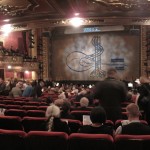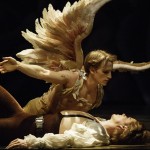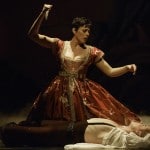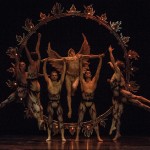Over the past few months I have had the extreme pleasure of dabbling in the Operatic arts. My first experience was the memorable and gut wrenching Italian tale of Tosca by the Canadian Opera Company followed by their more contemporary French offering Love From Afar.
This past weekend I was thrilled to be invited to the opening of Jean-Baptiste Lully’s Armide presented by Opera Atelier. This Toronto based Baroque Opera Company holds a unique place in the North American theatre community, producing opera, ballet and drama from the 17th and 18th centuries. These productions draw upon the aesthetics and ideals of the period, featuring soloists of international acclaim, period ballet, original instruments, elaborate stage decor, exquisite costumes and an imaginative energy. Atelier is not in the business of “reconstruction”, rather, each production is a new creative effort and takes its own place in history. The Company strives to create productions that would have been recognized and respected in their own time while providing a thrilling theatrical experience for modern audiences.
In February I took Lucky out for a Winterlicious review at Creme Brasserie. Over the course of our meal I discovered that she loved Opera, so promised I would take her next time I needed a date. Fast forward to Saturday night. Lucky arrived at my apartment shortly after 6pm for a quick cup of espresso and biscotti before we walked down Yonge Street to The Elgin and Wintergarden Theatre. I had been to this theatre a few times for TIFF Screenings, so was obviously over the moon that I would have the opportunity to experience Toronto’s most opulent theatre for a live performance.
Armide was a challenge for me. I sat through the show like I always do, staring at the stage, scribbling down my observations and searching for words that best describe my experience. I have a rule about how I allow myself to experience the performing arts for review: I’m not allowed to read anything about it before I arrive. My goal: to plop myself down in my seat with no clue about the storyline, context or characters. I hope to deconstruct the experience: how it inspired me, how I responded to the atmosphere, movement and music. At the same time I am looking at the piece from the standpoint of the general public: is the work digestible or easily understandable? Did the costuming, set and movement create a clear story for the audience?
Opera Atelier describes Armide:
The Muslim and Christian worlds collide in Armide, in which the invincible Christian knight Renaud and the Muslim warrior princess Armide play out their doomed love affair against a backdrop of hopeless obsession, jealousy and magic. Armide is a haunting, magical tale about unlikely lovers from two different worlds – he is the invincible Christian knight leading his army to victory in the Crusades, and she is a Muslim warrior princess fiercely determined to protect her homeland. Both are powerful leaders renowned as much for their victories in battle as for their otherworldly charisma. Armide has power over the heart of any man, but soon finds she cannot control her own: her hatred of her nemesis Renaud quickly turns to longing and she cannot bring herself to conquer him. As the story unfolds, our two heroes prove to be more alike than different – though each falls hopelessly in love with the other, both are determined to set aside personal happiness in the name of duty and valour.
After the show Lucky and I had an intense conversation about our impressions as we walked up Church Street back to my apartment. Our initial comments were that we felt a bit lost on the context of the story. The poster for the show features a portrait of Armide with arms covered in what appeared to be henna tattoos while the curtain at the beginning of the show featured an obvious Arabic script. The story opens with Armide and her companions dressed in brilliant jewel coloured dresses which did not seem at all inspired by the kingdom in which she represented. With a religious dichotomy central to the stories theme it would have been helpful to have a more obvious visual contrast.
In a very different way, we found it interesting how the depiction of good and evil had been showcased in such an obvious and traditional manner. The devil was joined on stage by a flaming hoop and throng of dancers dressed in Blades of Glory style tights. Evil was depicted as mature, machismo, strong and resolute. Goodness was represented by a short, fragile and beautifully blond angel with massive white feathered wings. Armide spends much of the tragedy tapping into this good vs evil paradigm first courting magic from the depths of hell for her destructive agenda and then embracing the gentle beauty of goodness. The tragedy that befalls Armide: what she thinks she needs to conquer may actually be what saves her.
Once I got home I lay on my bed and rewound the experience in my head. The highlight of the show for me was Atelier’s mix of dance and song. I was so pleased to see the conductor managing both the orchestra as well as a choir which sat to the left of the stage in opulently decorated boxed seats. Opera Atelier does a fantastic job of showcasing their interpretation of Armide into a modern work which equally celebrates French Opera and the poetry of the prance.
Following its Toronto run at the Elgin Theatre in April, the production tours to the magnificent Royal Opera in Versailles, France, and the prestigious Glimmerglass Festival in New York.









